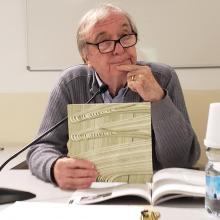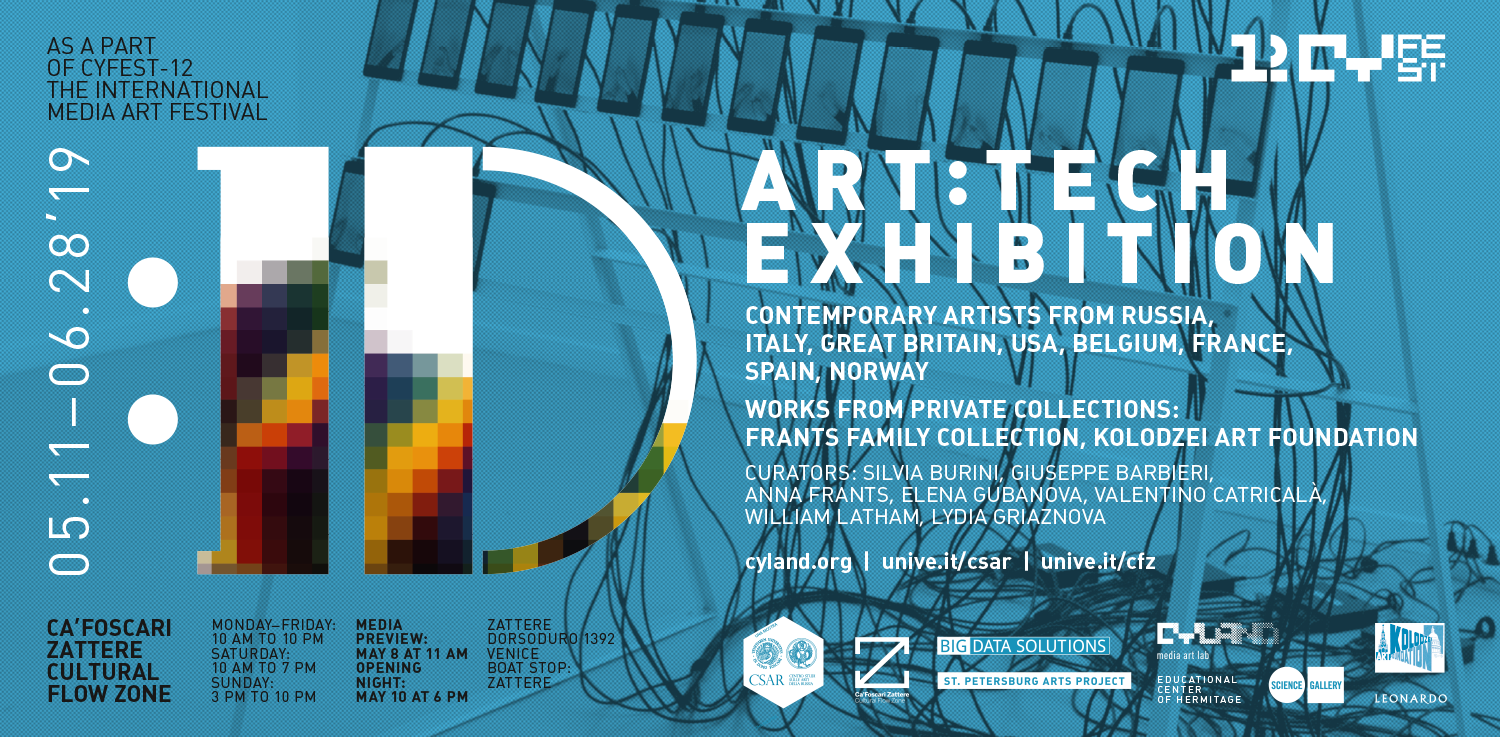
ID. Exhibition at La Biennale di Venezia
La Biennale di Venezia (Venice Biennale) brings together artists and the creative economy from around the globe, resulting in a woven tapestry of culture, identity and politics reflective of the time. As someone experiencing this otherworldly event for the first time, the Biennale provided me with an extensive reflection of the purpose of my visit. Leonardo/ISAST was invited by Cyland MediaLab and CSAR to present a critical context of how portraits and identity are explored by artists in emerging media and science as published in the Leonardo journal.
The curatorial statement of ID. ART:TECH EXHIBITION states it “is dedicated to the ID as a phenomenon with wide scatter of meanings – from the term in psychoanalysis (id) to the document that certifies one’s identity (ID). We are interested in what ID represents in the world of people and things, what new meanings come to life when they interact and what this leads to.”
This statement led me to frame my presentation around the article “Self-portraits As Presentations of Self” by W. Ray Crozier and Paul Greenhalgh in Leonardo Vol. 21 No.1, which describes the self-presentation theory: “The self-presentation theory proposes that claims to identity through presentations of self are a necessary element in social life.” I was happy to open up the series of events for ID elaborating on this concept with explorations of self-portraits in DNA, cybernetics, existentialism and selfie culture in an early afternoon session hosted by the Science Gallery—Venice. In good company, the subsequent lecture by Leonardo guest editor, author, and curator Michele Emmer provided a conversation of his journey with Leonardo as well as his upcoming exhibition on mathematics, bubbles and art.The ID. Art:Tech Exhibition shared the essence of its curatorial purpose in the diverse array of media and partners presented, many of whom exhibited Russian or post-Soviet points of view in either the aesthetic of the object or poetic meaning from which it derived.
Below are a few of the noteworthy pieces.
“Reflection on Life No. 125082” by Anna Frants (Russia–USA)
Installation: metallic conveyor belt, 3D print, Arduino, hand-knitting (2013) Robotics and computer programming: Alexey Grachev. Supported by CYLAND MediaArtLab.
I was compelled to imagine the morning routine of the child of the Russian writer Yuz Aleshkovsky, to whom the piece is attributed. In Frants’s statement for this piece, Aleshkovsky
“is said to have made the following schedule for his son’s edification:
8:00 wake up
8:05 brush teeth
8:15 reflect on life
8:30 have breakfast
And so on.In the work “Reflection on Life No. 125082,’ the numbering is provisional; let’s say that it starts from the date of birth No. 0, and the image in the Reflection on Life No. 1 should probably be seen upside down, the way a baby is supposed to see it… Do the ‘exercises of reflection on life’ make us better, wiser or kinder? I don’t know. Let’s leave that to Aleshkovsky’s son. I still think that Reflection on Life No. 1 is akin to Reflection on Life No. 125082; needless to say, this is true if one doesn’t delve into the RULES OF THE GAME that by now have been committed to memory.”
— Anna Frants
“The Invisible Handjob of the New Economy” by Ayatgali Tuleubek (Norway), 43-channel video installation, 2017.
Each channel is displayed on a smartphone. The phones are stacked on a rack and the installation borrows the setting and the aesthetics of click farms.
“In Chocolate” by Marina Alekseeva & Vladimir Rannev (Russia), multimedia installation, 2019. With the technical support of Sergey Karlov Supported by CYLAND Media Art Lab.
In this work, the viewer experiences a chocolate fountain layered with whimsical performances in augmented reality with an enticing composition provoking surprise and curiosity.
“Unforeseen Obligation YX7913XY” by Nataliya Lyakh (Russia–France), video installation: video projection on the surface of moving water, digital print on a transparent polymer, 2019.
Supported by CYLAND Media Art Lab.
This piece provided a metaphor for the cognitive triggers ignited by technology but through the calming experience of a water ripple created by a bird in water. The moment in reflection with this work moved between layers of reality or sub-realities.
For more of these works please check out our Instagram feed, Facebook page or the Exhibition Catalog.
You can see the exhibition now until 28 June 2019
Ca’ Foscari Zattere Cultural Flow Zone
Zattere, Dorsoduro 1392, Venice
For full details please see http://id.cyland.org
CYLAND MediaArtLab in collaboration with Centre of Studies of Russian Art CSAR presents the exhibition ID. ART:TECH.
From May 10 to June 28, 2019, in the space Ca’ Foscari Zattere Cultural Flow Zone, there will be a show of works by the contemporary authors from Russia, Italy, Great Britain, USA, Belgium, France, Norway as well as artworks by the classics of the 20th century. Among the exhibit’s participants are the New York underground guru of sound art and renowned minimalist composer Phill Niblock, Russian artist Andrey Bartenev, artist and curator of the Central Asia Pavilion at the 55th Venetian Biennale Ayatgali Tuleubek, St. Petersburg artist, curator, winner of Sergei Kuryokhin Award and Innovation Prize Peter Belyi, distinguished Russian artist and founder of sots art Erik Bulatov and others.
The project’s exposition is a visual examination of the subject of identification: from the forms of sociopolitical functioning of portraits of Soviet non-conformism to the images of mass culture, aesthetics of ID cards, passport picture and social networks.
The project will unite in one space the Soviet nonofficial art from Frants Family Collection and Kolodzei Art Foundation, video-, sound-, net-art, photography, installation and everyday objects.
Elena Gubanova, exhibition co-curator: “High technologies at the exhibition sit side by side with common items, the metaphor of “epiphany”—with irony, fine psychologism—with corporeality, infinity of the mirror reflection—with infinity of the digital data.
Painted portraits and collages of the underground artists from the times of “Soviet stagnation” lent by the collectors Natalia Kolodzei and Leonid Frants represent the time when a person’s ostracism was the price of self-identification as a free person. The video installation of the founder of American minimalism in music composer Phill Niblock and artist Katherine Liberovskaya about a depicted image engages into a dialogue with the work about a disappearing moment of St. Petersburg artist Peter Belyi. The monotonous rattle of cinema images in the video installation of the Italian artist Daniele Puppi echoes the little figures who are moving in a doomed fashion upon metal rails in the work by Anna Frants”.
Curators: Anna Frants, Elena Gubanova, Silvia Burini, Giuseppe Barbieri, Valentino Catricalà, William Latham, Lydia Griaznova

